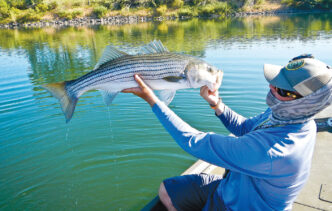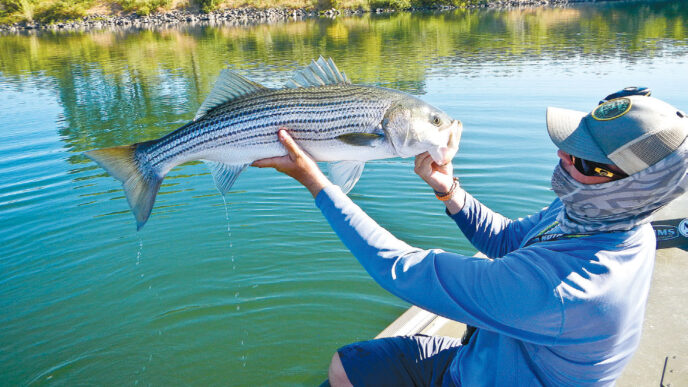Most of us can trace our passion for fly fishing back to a special place where the magic of catching trout on a fly was born. For me, that place was the Clark Fork of the Stanislaus River, several miles off Highway 108 between Pinecrest and Kennedy Meadows. During our annual family camping trip about half a century ago, we “discovered” the Clark Fork area while on an exploratory trip in the Stanislaus National Forest. I can vividly picture Uncle Johnny, who, as our wagonmaster, was in the vanguard of our caravan, beaming by the side of the road and telling us excitedly about his great find. It was the start of a decade of camping and fishing on the Clark Fork for two weeks each summer, an experience that led to my lifelong passion for fishing and wilderness experiences.
When my cousin proposed that we have a reunion camping trip on the Clark Fork, I signed up without hesitation. I wondered what a place that had meant so much to me in my formative years of angling and camping would look like after a hiatus of nearly four decades.
I loaded up the car and decided to follow the ritual with my wife and daughter of stopping in Oakdale at the Sno White Drive In, where my aunt Pat would treat us to hamburgers and milkshakes before continuing on our journey. Although Pat left us long ago, she was very much in my thoughts as I retraced our old route through the Central Valley and foothills to the alpine country of the Sierra Nevada. The scenery on the drive was as spectacular as I recalled from years ago. The Dardanelle Cone, a flat-top lava formation at over 9,000 feet elevation, dominates the horizon atop the upper Stanislaus watershed. I could make out the canyon where the Clark Fork flows at around 6,000 feet elevation from its origins near St. Mary’s Pass. As we drove up the narrow Clark Fork road, past the dramatic waterfall on the lower river, it still had the feel of a place that is off the beaten path. Although several popular campgrounds line part of the river, it is easy enough to find sections that are less visited or really get away from it all by taking one of the nearby trails into the adjacent Carson-Iceberg Wilderness.
Memories of what it was like camping and fishing on the Clark Fork in the 1960s came rushing back. I started out bait fishing at the age of seven for hatchery rainbows that were planted once a week at each of the four or five campgrounds lining the river. At Riverside Campground, I would sit on a favorite tree stump all day and patiently wait for as many hours as necessary for a trout to take my offering of salmon eggs. A few years later, I graduated to lures, but whether with bait or lures, I soon emerged as the perennial camp champ who recorded the most fish caught (and kept) during our campout.
The mystique of fly fishing started to capture my imagination when I was around 12 years old. There was Uncle Cliff, who visited camp for a few days and told stories of catching huge trout in Colorado with a bamboo fly rod and a grasshopper pattern. I also began to pay more attention to an older man, Mr. Hardman, whom we saw every year and whose elegant fly casting produced results with brown and brook trout, especially in the area downstream from Arnot Creek. Back in San Francisco, I started experimenting at Lake Merced with retrieving a fly attached to a clear bubble bobber, which turned out to be a very successful technique. By age 14, I was ready to take the next step in my fishing evolution and become a fly fisher.
Armed with a Fenwick fiberglass rod, a Pflueger reel, and some basic dry-fly patterns, I set out to discover what else one could catch on the Clark Fork besides planted trout. I soon found that wild brown trout, covered with bright red-and-black spots and sporting buttery yellow undersides, eagerly rose and took my floating flies. I explored a feeder stream and discovered that this small creek produced surprisingly large and hard-fighting rainbow trout in the clear plunge pools that lay hidden a few hundred feet from the hiking trail. I did my first overnight backpacking trip with a friend on this stream, which represented my start to many years of backpacking in the Sierra and the Rockies for backcountry trout.
It’s at about this point that the Clark Fork chapter ended for me, but the reunion provided a powerful reminder that my passion for fly fishing had its roots beside this pretty Sierra stream. In the intervening four decades, I have ventured to many of the fabled waters of California and far beyond its borders in my quest for the ultimate in fly-fishing experiences.
The time back on the Clark Fork, however, underlined how the skills and memories from those formative days stayed with me on my subsequent adventures.
It was on the banks of the Clark Fork that I first learned the word “etiquette” in the form of a compliment from a neighboring camper when I passed up the hole where he was fishing. I knew all of the best fishing holes on the river by heart and honed the skills of reading water and using stealth. The names of those holes still roll off my tongue: The Big Rock, Ruff’s Pool, The Stump, and many more. Although today I wouldn’t trade a day on the McCloud or upper Sacramento for one on the Clark Fork, I doubt that I will ever attain the same level of intimate knowledge of any stream that I had as a boy there.

All the great stories from that time are lodged firmly in my memory and get retold innumerable times with my brother and others who shared those early days on the Clark Fork. My brother and I still enjoy a hearty laugh when we recall how our father, who had never been camping or fishing in his life, arrived from San Francisco in his finely pressed Brooks Brothers slacks and shirt and then proceeded to slip into the icy-cold waters of the stream when he shifted his weight on the bank where he was sitting as he was trying to retrieve a bottle of salmon eggs that my brother asked him to pass over. After several failed attempts to climb back up on the muddy bank, my father took the long path to shore through the rushing waters as my brother and I fought against suppressed laughter and looked for a place to hide. I have accumulated many stories over the course of my various fishing trips, but the ones from my childhood days on the Clark Fork still hold a special place and never fail to delight and entertain.
The reunion and return to my youthful waters also reminded me of nearby destinations that merit more exploration and attention. I had taken the wagonmaster baton from Johnny and led family members on one-week backcountry trips in previous years, trips that so far have included the nearby Emigrant Wilderness and the Ansel Adams Wilderness. I don’t know if any of my young relatives have discovered a lifelong passion for the outdoors and fishing on these high-country trips, but at least a seed was planted and a family legacy was passed on. Other trips in the Stanislaus area on my short list of future destinations include fishing on the Middle Fork of the Stanislaus, exploring the seldom-visited northern backcountry of Yosemite, and more.
On the last day of our reunion trip, I reconnected with the early days by taking my 3-weight rod and plying the pocket water and plunge pools of the Clark Fork above Iceberg Meadow. After about 45 minutes of hiking along the trail that leads into the Carson-Iceberg Wilderness, I left the trail and picked my way down a gradual slope to the rushing waters of the upper Clark Fork. The Clark Fork at this point is a classic small Sierra stream that plunges through boulder gardens and features numerous small waterfalls and deeper pools that make for an ideal few hours of wet wading on a warm summer day. Although the trout (mostly rainbows, with a few brookies) are small, they are fun to catch on a light rod and make up for their lack of size with their bright colors and feistiness.
As I worked my way down the canyon, catching trout and fully immersing myself in fishing my childhood stream, the intervening decades melted away, and the constant that remained was the joy of fishing. Around the campfire that evening, I read a tribute to Pat and Johnny that included many fond memories of our trips and ended with an expression of my appreciation for the gift of the great outdoors and fishing that they bestowed on me. To paraphrase T. S. Elliot’s famous lines from the Four Quartets, I had arrived where I started and in some sense knew this place for the first time.
















